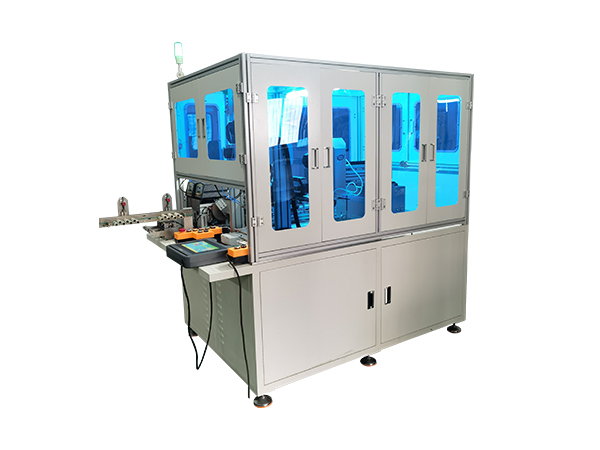The operation of automatic wire welding equipment can be divided into six core steps: startup preparation, parameter setting, workpiece clamping, starting welding, process monitoring, and shutdown maintenance. The specific process and key details are as follows:
I. Startup Preparation: Safety check and equipment initialization
Safety inspection
Make sure the equipment casing is well grounded to avoid the risk of electric leakage.
Check whether the emergency stop button, protective door, light curtain and other safety devices are sensitive and reliable.
Clean the welding slag and dust inside the equipment and on the workbench surface to prevent short circuits or jamming.
Device initialization
Connect the power supply and turn on the main power supply, the power supply of the control cabinet and the power supply of the welding machine in sequence.
After the system self-check is completed, enter the operation interface to check whether each axis (such as the X/Y/Z axes) has returned to zero and whether parameters such as air pressure and water temperature are normal.
Example: A certain auto parts manufacturer found that the Z-axis was not reset to zero when starting up the machine. By manually resetting it, the risk of collision was avoided.
Ii. Parameter Settings: Precisely match process requirements
Welding parameters
Current/Voltage: Adjust according to material thickness (for example, 1mm steel plate: current 180-220A, voltage 22-24V).
Welding speed: Balance efficiency and quality (for example, the recommended welding speed for aluminum alloy is ≤500mm/min).
Wire feeding speed: Matches the current (for example, when the current is 200A, the wire feeding speed is approximately 8m/min).
Gas flow rate: The flow rate of the protective gas (such as CO₂) is usually 15-20L/min.
Program call
Import preset programs (such as reading programs, parameter libraries) from a disk or USB flash drive.
A certain 3C electronics manufacturer achieved precise welding at the 0.1mm level by calling the "Mobile phone camera module welding program".
Adjustment of tooling fixtures
Adjust the position and pressure of the fixture according to the size of the workpiece to ensure the positioning accuracy is within ±0.05mm.
A certain medical equipment manufacturer has achieved precise alignment between artificial joints and titanium alloy rods through customized fixtures.
Iii. Workpiece Clamping: Stable Positioning and error-proof design

Workwear clamp
Place the workpiece in the fixture and manually tighten the screws or pneumatically clamp it.
Error-proof design: Positioning pins and sensors are set on the fixture to prevent the workpiece from being placed in reverse or missing.
An aviation component manufacturer integrates a pressure sensor on the fixture to monitor in real time whether the workpiece is clamped.
Automatic makeup clip (optional)
Combined with robots or loading and unloading systems, automatic grasping and positioning of workpieces can be achieved.
A certain home appliance manufacturer has achieved unmanned clamping for the welding of air conditioner compressors through the cooperation of a six-axis robot and a vision system.
Iv. Initiating Welding: Automated Process and Manual Intervention
Manual start
Press the "Start" button, and the equipment will perform welding according to the preset program.
Operation details
Observe whether the movement trajectory of the welding torch matches the workpiece.
Listen for the welding sound (a shrill sound may indicate excessive current).
For example, a certain car manufacturer determines whether the weld seam is fully penetrated by sound when welding car doors.
Remote control (optional
Welding can be initiated via a remote control or a mobile phone APP, making it suitable for hazardous environments (such as welding of nuclear power equipment).
Example: A certain nuclear power equipment manufacturer remotely operates a welding machine within the radiation area through an explosion-proof remote control.
V. Process Monitoring: Real-time Feedback and Anomaly Handling
Data monitoring
Parameters such as current, voltage and welding time are displayed in real time through HMI (Human-Machine Interface) or SCADA system.
A certain battery manufacturer uses a SCADA system to monitor the welding temperature to prevent the heat-affected zone from being too large.
Visual inspection
Integrated CCD cameras or laser sensors can detect defects such as weld width, excess height and porosity in real time.
A certain semiconductor manufacturer inspected the quality of chip pin soldering through a visual system, and the defect rate dropped from 0.5% to 0.02%.
Exception handling
Alarm response: If the device prompts "Insufficient gas pressure", immediately check the gas source and replenish the gas.
Emergency stop: In case of sudden situations such as workpiece displacement or welding torch collision, immediately press the emergency stop button.
For example, a certain ship manufacturer was welding the deck when the workpiece was not clamped tightly, causing the welding torch to collide. The equipment was prevented from being damaged by pressing the emergency stop button.
Vi. Shutdown Maintenance: Extending equipment lifespan
Daily maintenance
Clean the welding slag, replace the wire feeding tube and lubricate the guide rail.
Example: A certain construction machinery manufacturer cleans the cooling fan of the welding machine every day to prevent overheating and shutdown.
Regular maintenance
Replace the filter, check the insulation of the cable and calibrate the sensor every quarter.
Example: A certain new energy vehicle manufacturer calibrates the energy output of the laser welding machine every quarter to ensure welding consistency.
Fault record
Record the alarm codes and maintenance history of the equipment to provide a basis for subsequent optimization.
A certain electronic manufacturer analyzed the fault records and found that a certain welding machine frequently reported the "overcurrent" fault. Eventually, the problem was solved by replacing the power module.
about
Introduction video case honor partners factoryproduct
Automatic welding line Non-standard customization Automatic soldering Glue/screw lockingnews
dynamic Information faqCustomer Service
contactMr. Xia:+86 186-7696-3763

WeChat QR code

Douyin QR Code
Copyright © 2025 Copyright © Dongguan Chuangxiao Automation Technology Co., Ltd.
本站相关网页素材及相关资源均来源互联网,如有侵权请速告知,我们将会在24小时内删除